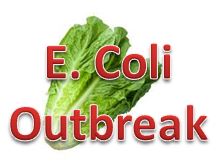The Latest Update in the E. coli romaine lettuce outbreak from FDA and CDC
Outbreak update
 Update reports from both the CDC and the FDA summarized the status of the outbreak after its conclusion. As of June 27, 2018, the human toll from the romaine lettuce outbreak was: 210 people infected with the outbreak strain of E. coli O157:H7, 96 hospitalized, 27 developed hemolytic uremic syndrome, and 5 deaths were reported from 36 states. The most recent victim became sick on June 6.
Update reports from both the CDC and the FDA summarized the status of the outbreak after its conclusion. As of June 27, 2018, the human toll from the romaine lettuce outbreak was: 210 people infected with the outbreak strain of E. coli O157:H7, 96 hospitalized, 27 developed hemolytic uremic syndrome, and 5 deaths were reported from 36 states. The most recent victim became sick on June 6.
In an evaluation of the environment in the Yuma growing area, including water, soil, and manure, the CDC laboratory identified the outbreak strain of E. coli O157:H7 in water samples taken from a canal in the Yuma growing region. Additional strains of Shiga-toxin producing E. coli were found in the water samples, but initial testing of these isolates indicates they are different than the outbreak strain.
The authorities did not reveal the canal location or how the bacteria got into the canal. In a statement by Scott Gottlieb, M.D., FDA Commissioner, he said that “More work needs to be done to determine just how and why this strain of E. coli O157:H7 could have gotten into this body of water and how that led to contamination of romaine lettuce from multiple farms.” They also did not discuss why it took them so long to test an obvious source of contamination, such as the irrigation water.
The CDC used whole genome sequencing (WGS) that provided fingerprints for pathogens was used to analyze 184 isolates from ill consumers. They found that the E. coli O157:H7 causing the outbreak was resistant to chloramphenicol, streptomycin, sulfisoxazole, tetracycline, and trimethoprim-sulfamethoxazole. Isolates from four of those ill people also contained genes for resistance to ampicillin and ceftriaxone. However, these resistances do not impact patients since these antibiotics are not recommended for treatment of E. coli O157 infections.
CDC and FDA need to do more work to determine just how and why this strain of E. coli O157: H7 could have gotten into this body of water and how that led to contamination of romaine lettuce from multiple farms.
New techniques make the investigation more efficient
In his statement, Scott Gottlieb, FDA commissioner, praised the work of the CDC during this outbreak and the utilization of new technologies such as WGS claiming “What’s happening is that our ability to identify outbreaks has dramatically improved due to new information technologies and laboratory techniques. “
Dr. Gottlieb said “Despite our best efforts to ensure the safest food supply possible, foodborne illness continues to occur in the U.S. and elsewhere around the globe. In the U.S., CDC — the agency that primarily detects multi-state outbreaks of illness — estimates that foodborne illness affects nearly 50 million people annually, which is about one in six Americans. Of these, an estimated 128,000 people are hospitalized, and 3,000 die each year. These numbers are tragically high… We need to take additional steps, and do it faster, to improve the safety of our food supply. “
He promised that”When appropriate and available, we’ll release information on retail outlets where contaminated foods may have been purchased if this information can quicken a recall or help a consumer better identify a product.” as was done with pre-cut melon.
Missing from this discussion is the need for better tracking mechanisms that will allow the FDA and food manufacturers and processors to quickly identify the source of an outbreak and remove the products from the shelves.
Finally, Dr. Gottlieb said, “I remain committed to investing in FDA’s food program, and building on its success — and to applying the FDA’s food safety expertise to protect American families and keep them safe.”
